In religion and spirituality, it is said, a pilgrimage is a long journey or search of great moral significance. Sometimes, it is a journey to a shrine of importance to a person's beliefs and faith. From time immemorial, members of many major religions have participated in pilgrimages. A person who makes such a journey is called a pilgrim. For some of us, handball is a religion and that is no disrespect to the traditional and religious among us. Suffice it to say, this one pilgrim’s journey.
The journey to Toledo (Maumee), OH for the 60th USHA National Three- Wall Championships is the pilgrimage of our sport. The caravans arrive from the four directions and all points in between. Tents are pitched, blankets are unfurled and generations gather at this sacred place for a feast of friendships and fabulous handball.
This is a family affair on so many levels. There are the families that have been coming to Toledo for this event for as long as it has existed at this venue. As a result, there are children who have grown up at this event and now have children of their own having made this journey to continue a rich and hopefully lasting tradition. To take away nothing from the rest, these are the royalties of our sport. As grandfathers, fathers, mothers, sons and daughters from the same families compete in either a skill division or age appropriate bracket, the whole atmosphere is charged with a sense of spirituality and camaraderie among the larger handball family.
It was into this atmosphere I felt welcomed. I was awed and humbled from the first moment of arrival and knew I was about to enter into a special realm.
Early Thursday morning after being on the road for 7 hours (Thank you Nan for taking care of the driving!); getting a few hours of shut eye, I was eager to find the venue and check in for my 11 AM match. Matches had already started, a little later than scheduled because it had rained in the early morning hours and that usually requires the torches to dry the concrete before start of play at this and any outdoor handball venue. And with the sun and humidity making their presence felt toward late morning, I was ready to embark on what would prove to be both a remarkable journey and a spiritual awakening in the realm of handball.
Seeing familiar faces soon after arrival lifted my spirits and helped calm my nerves. To be honest, I had nary a clue what was to unfold over the next five days. Since it was early in the tournament, I had a choice of courts on which to play. After selecting court seven, I later selected court eight because I thought it looked in better shape. As any handball player knows, no two courts are exactly alike, and on different days, the ball may bounce a little differently. But those are the quirks of the game, and in the end, it is the relative skill of the players that factors in the most.
Entered in the Men’s Singles Golden Master B (50+) single elimination event, my 11 AM opponent, Alan Viets from Michigan kept me waiting because he went to the wrong court. But as he approached, he recognized me as someone he played several years ago in a friendly match we arranged while he had traveled to Washington, D.C. on business. Admittedly, I had not made the connection when I studied the draw and noted the name of my first opponent. Upon seeing the man, I recalled our games. He may have had the advantage at that first meeting, but I know I have made significant progress since then and looked forward to the challenge.
I won the right to serve first and promptly lost it on a passing shot hit as return of serve. I could feel the butterflies as my gut tightened. I remembered to breathe and settled down some as we battled back and forth, neither player truly taking command. At the beginning, a lead of five points was the most held by either one of us. In between, there were numerous side outs, often buttressed by long rallies. Finally after these long duels, Alan forged ahead by a few points as I would battle back to tie the score or go up by a point or two. And so it went until I was able to close out the match by winning 21-18.
The first game was long and I began to feel heaviness in my legs. The five minutes between games helped to revive me. As we began the second game, Alan ran out ahead and I could not counter. All the off court advice was welcomed, but my execution was poor. I only hoped to keep the game in sight by not allowing my opponent to leave me in the dust. Behind by six or seven points and in danger of letting the game and perhaps the match get away from me, I found a gear that leveled my game. I started making the right shots and began scoring points with greater frequency while not allowing any runs on exchange of serves. After one long rally, which I won, I saw my opponent with a look of discouragement in his demeanor and that was a signal to pounce. I started driving the ball deep on serves and returns as my points total edged closer to my goal. And after what was a long and arduous match, I emerged victorious 21-14. I shook my opponent’s hand walked off the court full of pride and emotion because I had just won my very first match! It was now well after 1 PM and I would have to recover significantly to play again in the evening. It must be noted that it is unusual to play twice in one day within the same bracket at a national tournament. But as unseeded player, such was my lot.
Before heading back to the hotel, I was able to watch Pat Lowery play, a member of the DC/DE/MD/PA/VA/WVA handball family who collectively play in Columbia, MD and are well represented here in Toledo. Pat is a veteran of many campaigns to Toledo. It was fun to watch him compete in this first round match as he always does well in advancing through his chosen bracket. And advance he did, as he dispatched his opponent 21-7, 21-9. Pat would later play a marathon match in the quarterfinals round with the eventual champion Terry Peterson (Des Moines, IA). In that match, Pat pulled out the first game 21-19. In the second game, Pat had trouble finding his shots as he seemed out of position on most returns. The result was a 21-6 loss which led to the 11-point tiebreaker. Whether in tournament play or a so called ‘friendly,’ tiebreakers seem to be Pat’s specialty. From viewing results, over the years he has played in so many. This match against Peterson was a close and tight 11 point game. There were beautiful points and crowd pleasing shots. But in the end, Peterson outlasted Pat and won, 11-8.
It is often said, ‘There is no rest for the wicked or the weary.’ In my case, weariness foiled my attempts at a few hours sleep between my morning and evening match of the first day. I rested, but could not find the solace of deep slumber. Although hours of music calmed and soothed my nerves, it was no substitute for the rest my body truly required.
I arrived for evening match refreshed and relaxed but wishing that I could have slept. As the schedule would have it, it seems my match was the featured match of the evening because it was slated for court six, the center court at Toledo, sight of the Open finals.
As I strode on the court to warm up and meet my opponent, the setting sun cast long shadows on the court floor as the orange fading light dazzled off the front wall. With artificial light already lit, transitioning to night play would be made easier. With one of the largest contingencies of supporters gathered to cheer me on, my handball family made me feel right at home.
Ernie McGarry from Seattle, Washington introduced himself as we warmed up. I realized, he had watched my first round match earlier in the day and would have certainly picked up on my strengths and weaknesses on display in that event. Apparently, he was a quick study. Between his fine play and my molasses like pace, I found myself in a hole from the start and the hole only got deeper. I was enamored by the fact that I was so relaxed and felt little or no anxiety, and it unfortunately showed in my lack of effort. Even with the most familiar of voices shouting encouragement, I was unable to score and darkness fell outside the court as I failed to muster a single point in the first game.
Playing under the lights for the first time presented no problem as long as the ball did not leave the confines of the three walls. On deep shots outside the court, the ball is momentarily lost in the twilight that exists in the court extension. I gathered myself between games and started the second game with crisper serves and shots. I edged out to a 5-0 lead. That soon evaporated as Ernie played smart handball and built a sizable lead. With Ernie being ahead 14-5, I found new handball life and played with passion and zest. I did not quit even though my legs felt like lead. The will to extend the match was strong as I sought to level the score. Ernie too found new handball will and kept me at bay to win 21-15. The score was a small consolation for not scoring in the first game and not quitting after being down in the second.
After one loses in a tournament, there is an obligation to referee the next match scheduled for your court. Dan Ho (Columbia, MD) vs. Jerry Yee (NYC) from the Men's Singles Super Master (60+) Single elimination bracket got off to a fast start as Dan mixed his often effective lofted right side serves that Jerry had trouble returning. Dan also used this as an offensive shot and scored some of his points via this tactic. After several exchanged side outs, Dan seemed to pull away and beat Jerry, 21-8.
The second game found Jerry finishing rallies quickly and efficiently, limiting Dan’s use of his most effective weapon, the loft down the right side. Keeping Dan out of the service box allowed Jerry to mount a sizeable lead of 14-5. After a brief time out, Dan found his magic and scored 11 unanswered points, the last coming on a marathon rally that featured high and low gets from seemingly impossible angles and positions. With the point won by Dan, both players looked exhausted and in a moment of gamesmanship, Jerry looked to Dan to call a timeout, but Dan’s response was a desire to serve. Jerry graciously asked for a needed and deserved time out. After the minute rest allotted for a time out, Dan clearly had the momentum on his side and pressed the issue as Jerry had given his all in the draining rally. And although Jerry served again, Dan, still energized from his winning rally, closed out the match, 21-16.
Other matches continued, but our day was ended as many of the Columbia, MD three-wall family gathered for what is a standing tradition of a Thursday night meal at a local restaurant. I felt welcomed into one of the many traditions born of this pilgrimage.
Losing to Ernie was hard, but he and I bonded and had many a wonderful conversation for the rest of the tournament. Ernie proved to be a classy player and person. We were still connected because Ernie’s next opponent in the Friday quarterfinals was Steve Bossung (Harpers Ferry, WVA), my doubles partner from another bracket in the tournament.
It is an ironic feeling to root for the one who eliminates you from competition. But my loyalty was to Steve my partner in the Friday match. Again, because of tremendous downpours in the early morning, the match schedule was in disarray for the entire day. The noon start for the Steve and Ernie quarterfinals was pushed back until mid afternoon. Finally underway, Ernie took advantage of Steve’s serve and passed him to the deep left, racking up points at will. Though Steve’s first round match was easily won at 21-4, 21-5, his quarterfinals against Ernie proved tougher and in the end, Ernie prevailed, 21-10, 21-8. Now, rooting for Ernie would be easier since he had eliminated Steve and moved to his semifinal half of the bracket. Ernie’s next opponent on Saturday proved too tough and overpowered Ernie, 21-11, 21-10. The winner played in the finals against eventual champion, Terry Peterson (IA).
Traditionally, Friday is the longest day by virtue of having so many matches played. With a weather delayed late start, it would mean matches lasting well past midnight. And it seems weather wanted to continue playing a part in the action as Friday’s mid afternoon temperatures plummeted and the wind became brisk.
Since my next scheduled match was pushed back from a 7 PM start time until much later, I could conceivably watch many matches. Of course, as a family, we all show support for each other and the Columbia family is no exception. With the tournament getting into full gear, matches are backed up on courts so one can stake out a spot or if the schedule falls right, as it did on Friday, many of the Columbia player’s matches were held on the same side of the 8 court divide.
A featured match pitted Dan Zimet playing out of Columbia, MD against Kirk Rys from Chicago, IL. In the first game, Rys gave Zimet as much as he could handle and kept the match close. Matches that are often close can sometimes turn on close play that breaks the spirit or a missed call by the referee. On one or the other, this game and eventual match turned. Dan was able to hit is precise low right hand side serves that set up textbook kills of weak returns. Rys was never as competitive as the first half of the first game, and Dan closed him out 21-14. The second game was never in doubt as Zimet took control and pressed on to a 21-6 victory and the match.
Zimet’s Saturday opponent was much tougher and by all accounts tested Dan and forced an 11-point tiebreaker which Zimet seem to win easily at 11-2. The win put Zimet in Sunday’s Final against Bob Nicholas of California. In the first game, Dan raced out to 6-0 lead by keeping Nicholas off balance with his serves. After Nicholas made it close for a few points, Zimet pulled away with crisp kills and well timed passing shots that had Nicholas chasing and retrieving only to have his somewhat ineffective returns put away. The start of the second game was the mirror image of the first; as Nicholas raced out to a 6-0 lead. Zimet calmly inched back and tied the match and then passed Nicholas, allowing only 3 points the rest of the way and securing his 11th National Masters title, 21-9.
Friday also saw, Dan Ho go up against Vance McGinnis of Illinois as play continued in the 60+ singles bracket. Vance is a perennial favorite to win this division and presents problems for most players. McGinnis is a tall lanky man that uses his height advantage to cut off or reach back for shots. Shots that would ordinarily force other players to move or run back, McGinnis only takes in stride. Ho had his work cut out for him and turned the event into and entertaining spectacle. At 21-10, 21-7, Ho showed great tenacity in keeping the score respectable. Embracing at center court after the match, the height disparity could not be more evident.
As the Friday evening rolled along, Lee Anderson (Columbia, MD) was pumped for his A Singles match against known rival, Will Bardwell (Columbia, MD). With families watching, there was an atmosphere of great anticipation as to which one of these young lions would win the day. From the very first serve, Anderson was in control. The machine like precisions of his low hopping serves kept Bardwell guessing and missing. The first game was short as Anderson limited Bardwell to 2 points. The second game was more of the same as Bardwell only managed 4 more points than the first game as Anderson executed his will to win 21-6.
In Saturday’s semifinal match, Anderson came up against Daniel Mcnabney from Rochester, NY. With temperature well below normal warmth, this turned into a knock down drag out battle with neither player seeming to flinch. It was a battle to be remembered for its artistry and tenacity shown by both players. After winning the first game 21-10, Anderson fought hard to keep the momentum going and seal a victory in the second game. The fiery display of intensity had the spectators in awed appreciation. The somewhat biased crowd cheering for Anderson buzzed with each point. Coming up short at 21-18, Anderson braced for the 11-point tiebreaker. The game progressed with Anderson in a deep whole, but he clawed his way back to tie the score at 7-7. From this point on, the tension mounted as body language and hearts reacted to every contact of the ball. Both players served at 10-10, but it was Mcnabney who managed to eke out the victory on a miss hit by Anderson. Even though losing at 11-10 in a tiebreaker can be tough on anyone, collectively, the spectators all felt the ache for Anderson in this defeat.
Of note, in the Sunday finals, Mcnabney emerged the A singles champion in a grueling match against Paul Angel from Brooklyn, NY, 21-18, (17-21), 11-6. Paul Angel had come up against Dave Bardwell (Columbia, MD) on the other side of the bracket in the Saturday semifinal round. Despite a fine showing in the bracket, Dave was bested by Paul, 21-16, 21-11.
The late Friday evening into night was just getting warmed up with action as the brisk chilly air nipped at the ill-prepared players and spectators alike. Everyone did their best to stay warm.
As other matches played out, our interest turned to local (Columbia, MD) favorites, Rick Anderson and Tony Winter in their match in the Men's Doubles 50+ Single Elimination division. Rick and Tony efficiently went about their task with precise play as Rick controlled the front court and Tony blanketed the back, at times reaching far beyond the confines of the 3-wall enclosure to hit effective ceiling or high front wall shots. The discipline in this team’s play is to be admired and emulated as it epitomizes winning efforts by a doubles team. Winning 21-2, 21-8 over the team of Jim Tamagni (California) and Joe Havener (Illinois) put Rick and Tony up against Ray Estevez and his partner Scott Rosenthal (Illinois) in a Saturday semifinal. Again, the timbre of the match can only be described as tenacious. Rick played the front like a master, directing shots from high and steering them to sudden death via corner kills. And whenever there were straight out kills, unless rolled out, Rick’s body would be prone and the ball returned to be in play or end the rally. Taking the first game 21-15, Rick and Tony geared for the Estevez rally. Ray is a controlled player with the quickness and skills to match Rick upfront. At 21-18, Ray and Scott squared the match and girded for the 11-point tiebreaker. The excitement of any tiebreaker is always multiplied whenever the score is kept close as this game was. However, Ray and Scott were able to somehow find a way to exploit a few tactical errors and won 11-8. The result put Ray and Scott in the semifinal against Jim Corrigan (Cleveland, OH) and Phil Kirk (Maumee, OH) who have dominated at this level for years. Their collective domination is most often interrupted by the other dominant team in the bracket and this year’s eventual champions, David Dohman (Indiana) and Tim Sterrett (Illinois). It was the team of Dohman and Sterrett that awaited Joe Berman (Columbia, MD) and Dan Ho after their first round wins over James Kreger and Jeff Grilliot, both of Ohio, 21-7, 21-8.
Although Berman and Ho gave their all, Dohman and Sterrett proved too powerful and advanced, 21-6, 21-11.
Men's Doubles 50+ Single Elimination is the bracket that Steve Bossung and I competed in. Our first obstacle was the team of Joe Ivy and John Early both from Michigan. Being new to the Toledo scene, any player information is helpful. To that end, everyone mentioned Joe Ivy’s name with respect. Well after 9 PM, with the wind howling and the temperature steadily falling, Steve and I took the court against Early and Ivy. With Steve mostly playing up front and me in the back, we sometimes were caught out of position and the more experienced team took advantage and piled up the points. A combination of steady play by Early and Ivy and more erratic play by Steve and I led to our swift dismissal from the tournament to the tune of 21-7, 21-11.
Early and Ivy would later face the aforementioned Corrigan and Kirk and meet a quick defeat at 21-1, 21-8.
Of note, Joe Ivy teamed up with Bob Bardeau (Ohio) and defeated Bob Dyke (Columbia, MD) and Ken Greco (Connecticut) in the semifinals of the Men's Doubles 55+ Single Elimination bracket on their way to a thrilling championship victory over John (Sean) Coneeley (Illinois) and Tim Murray (Florida), 21-13, (7-21), 11-10.
The end of Friday night could not come soon enough, with cold air swirling and the tainted taste of defeat languishing in my mouth. And even though I wanted to stay and cheer on Lee and Eric Anderson in their A doubles match, the combination of elements and weariness forced me to retreat to find food, drink and the warmth of my in room Jacuzzi.
Saturday was cold and clear and forced many participants to local stores to find warm weather gear. In all fairness, the coldness was exacerbated by the fact that everyone dressed for summer. Shorts, sandals and the mindset to be playing outdoors usually do not coincide with cold snaps.
Upon reflection of the previous night’s loss, I felt a great disappointment that I would not be playing in this year’s tournament anymore. It was a sad feeling despite the great handball that I had seen and was sure to follow in the remaining days of the tournament.
Saturday is the middle day of the tournament and the evening feasting was scheduled. Apparently food and beverage are another tradition of the Toledo experience. With meats being prepared fresh daily and free flowing draft beer, if one only came to eat, drink and watch handball, there would be a great satisfaction to be had.
After hearing so much about Toledo for all these years, it was great to experience it for myself. Getting to meet people and seeing great handball ranks among the fine experiences of life. But this story continues with more Saturday matches on the schedule; and with none of my own to look forward to, I volunteered to referee the Women’s Open semifinal match between Sandy Ng (Brooklyn, NY) and Samantha England (Rochester, NY).
Sandy Ng, at 17 has the distinction of being the youngest women’s National Open Champion, gaining that honor by recently slamming (winning Open Singles and Open Doubles) in the One Wall Nationals held in Brooklyn, NY in August 2010. It was both an honor and a pleasure to referee this semifinals match between a older champion and a rising star in our sport. And even though the women’s divisions play with a lighter, livelier ball, their skills are as accomplished because the courts and conditions are otherwise equal.
Ng and England go at it from the start and push each other with deep shots and terrific kills. The two women battle back and forth with Ng prevailing 21-15 in the first game. The second game found Ng in complete control, hitting passing shots at will and serving a low hopping right side bullet. England had trouble handling that serve as Ng piled up points and was poised to end the match, up 20-16. Serving for the match, at some incident Ng became rattled; and never regained composure and lost the serve. England then followed with five straight points to win the game and level the match. Between games, Ng gathered herself and finished England 11-5 in the tiebreaker.
Of note, being a referee for the women is quite different from the men. The women are generally less argumentative than the men, with one noted exception at this tournament.
Ng would lose in the semifinal to the eventual Women’s Open Champion, Tracy Davis (Arizona). But redemption would be had by teaming up with Samantha England and besting the doubles team of Tracy Davis and Teresa McCourt (Staten Island, NY) in a riveting Monday match, 21-17, (19-21), 11-10; the last point coming off a deep serve to left wall that slid and hooked left as it left the court with Tracy Davis reaching in vain to retrieve the elusive ball.
Saturday play continued with many quarter and semifinal matches to sate the viewing pleasure. Among my favorite divisions to watch is the Open. In the Open division, the level of play surpasses and surprises even the wildest imaginings of play in our sport. Speed, precision and ease separate the elite among the Open player. This year’s championships offered a plethora of players in the men’s Open division, headlined by David Chapman (Missouri), Luis Moreno (Arizona), Tyree Bastidas (Brooklyn, NY), David Fink (Pittsburgh, PA), Dane Szatkowski (Illinois), Andy Nett (Minnesota) and a host of others too numerous to mention. One notable absence from this list is Sean Lenning (Seattle, WA) who could not make the trip because of injury.
From this smorgasbord of potential match ups, I settled in and watched the phenomenal talent of Luis Moreno in his quarterfinals match against Andy Nett. To say Moreno overwhelmed Nett would be an understatement. As I watched the match sitting with Nett’s dad, even though he was proud of his son, he could not help but be awed by the skill and ease with which Moreno dispatched his boy. Moreno is an efficient player who seizes every opportunity to put away a shot; using knife like kills with either hand displaying power or soft finesse. After getting 9 points in the first game, Nett was limited to 3 in the second.
Moreno is a nice young man. After being introduced to him, we spoke a few times during the tournament and his on and off the court demeanor are to be commended. I mention this in contrast to the bratty behavior of other Open players on display here and at other tournaments.
For the next round, Moreno went up against Tyree Bastidas. Tyree has skills beyond belief. To see them plied on the court is a thing of beauty. But they are most often overshadowed by Tyree’s penchant for drama and over reaction to the slightest disturbance in the atmosphere. I like Tyree and I love his skills, but his gamesmanship and court conduct is lousy. In fairness to the young man, it has improved, but still has a ways to go. Tyree may be a champion, but he has no idea what it means to be a champion. But I digress. Moreno and Bastidas squared off in beautiful battle that matched skill for skill. As one player/spectator who watched the match commented on a riveting sequence during one game, “Yeah, I can do that, perhaps one in several thousand tries.” And so it went, shot after shot and rally after rally with Bastidas besting Moreno, 21-15 (19-21), 11-4.
Before Bastidas was able to face Moreno, he had to outlast David Fink in terms of skill and on court antics. The spectators anticipated melt downs for which both players are known and they also anticipated spectacular play. They were treated to both. Again, when equally matched players face each other, sometimes a game or match can turn on a single bounce. Bounces and bashes dominated the play with Tyree taking the first game 21-19. Taking his antics to another level, Tyree pounded his hand against the concrete several times and apparently damaged his right hand. The realization and pain must have set in because Fink took advantage and easily won the second game 21-10. The tiebreaker was scintillating as Tyree snatched the win 11-10.
The Monday Open final pitted Tyree against David Chapman who was never tested on his side of the draw. Chapman is legendary in his play. He is always in control, though at times does display diva like dishes. He does play a beautiful game mixed with power and supreme finesse. Seeing him execute the corner kills sends chills up and down the spine. Chapman also rarely makes mental errors. He reduces and expands the court at will and seems to calculate every shot to within a precise micron. As so, an injured Tyree was no match for Chapman who generously allowed 11 points in the first game and became stingy in the second, parting with a mere 5.
Returning to Saturday play, Alan Frank (Columbia, MD) teamed up with Mark Zamora (Fontana, CA) to begin round robin play in the Men's Doubles – 45+ division. What a lethal team these two Grand Masters proved to be. With Frank dealing booming arches from the deep court, Zamora simply sliced and diced his kill shots to all angles in front. In the three matches played on the way to the Monday championship, this team was never challenged beyond a few contested points. No opponent scored more than 9 points in the three matches.
Frank also teamed up with his long time doubles partner Dan Zimet to compete in the Men's Doubles 35+ division. Seeded number one, the path to the Monday finals was made less arduous as they handled their first opponents, 21-7, 21-11. In the finals, Zimet and Frank met with the number two seed, Shane Conneely (Illinois) and J. Komsthoeft (Illinois). This was a tight match controlled by the younger team from Illinois. Frank’s sure-footedness and precision from the back was tested and often bested during the match. While Zimet’s up front game is his bread and butter, the usual consistency was noticeably lacking throughout both games. Though Frank and Zimet threatened, their threats where never fully materialized and at 21-15, 21-14, Conneely and Komsthoeft were crowned champs.
The Frank family dynasty expanded as young Nathaniel played his way through the Junior Singles – Boys Juniors round robin draw. Playing 4 games and winning all, Nathaniel was only truly tested by Dylan Graham (Michigan). Dylan took Nathaniel to a tiebreaker in their match, a game Nathaniel won 11-2.
Mark Zamora teamed with Bob Nicholas (California) to control the Men’s Doubles 40+ division. Jay Miller (Columbia, MD) and Rick Anderson competed in this bracket which saw them advance to the semifinals in their half of the bracket. Their loss (21-12, 21-7) to Pete Hanover and Patrick Meyers, both from Michigan put Hanover and Myers in the finals against eventual champions, Nicholas and Zamora.
Jay Miller also gamely competed in the Men's Singles Veteran Masters (45+). Jay injured himself in an earlier doubles match that severely limited his play going forward. However, Jay did reach the finals in this division but could only muster 5 and 9 points against Marty Clemens from Tennessee.
Ray Estevez competed and emerged champion in the Men's Singles Veteran Golden (55+) division. The bracket was stocked with the likes of the aforementioned Bob Bardeau (Ohio) and Tim Murray (Florida). But neither Bob nor Tim made the finals. Ray faced John Friedrich (Ohio) and lost the first game 21-7. However, Ray found his stride in the second game and returned the favor, 21-6, thus setting up the match deciding tiebreaker. Although I did not witness the event, the results speak for themselves, 11-5.
In a moving ceremony on Sunday afternoon, the latest players to achieve Grand Master status were honored as matches were stopped and Dan Zimet and Mark Zamora were presented with sweaters to mark the occasion. I cannot say enough to congratulate both men on their remarkable achievements.
To close out this year’s competition and whet my appetite for games, I signed up for the consolation round. Consolation rounds are just that, they serve to console and perhaps give the winner the satisfaction of knowing he may be the best of those who lost in first round play. Well, not everyone signs up and of those who sign up, not everyone shows up to play. The matches, taken seriously by the participants, are sometimes looked upon a little less favorably by those who are still competing within the brackets. This is my own perception, but that is also a general feeling I gathered.
After the consolation draws were posted on Saturday, Sunday play was scheduled. I was excited to play again. My first opponent was Jim London from St. Louis. Jimmy is hard to miss because he well liked and is a fixture at the tournament. He is also mentally challenged. But as I found out Jimmy likes to play and if he can hit the ball, he will make good shots. So I played with Jimmy and let him hit the ball and score points in each game. He is like a little brother who should be encouraged. My next opponent whom I played a couple hours later as courts became available was Rick Jackiw from Ontario, Canada. Rick is limited in his movement and wears removable knee braces. This was a modest victory to put me in the finals against Guy Ingram from Florida. To put it openly, Guy was looking for someone to beat and he blew by me in quick games 21-3, 21-5. I was just happy to play and congratulated Guy on his win.
This was the very first pilgrimage to Toledo and by far, my greatest handball experience to date. I found the experience fun, enriching, eye-opening, exhausting, warm, and friendly. I learned a lot about myself and I saw our sport being played at spectacular levels. The most fascinating aspect of this trip was to be able to see the players I have read about for years. Beyond our local contingency, I met the elite of three-wall handball and drank in (including the beer) all I could. But from the moment I was eliminated from competition, my thoughts and frame of mind began to focus on the task at hand: How to prepare for the next pilgrimage to Toledo.

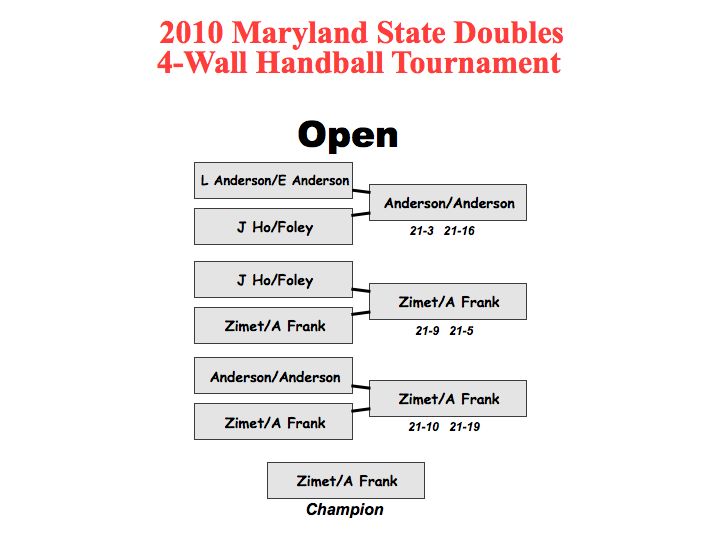

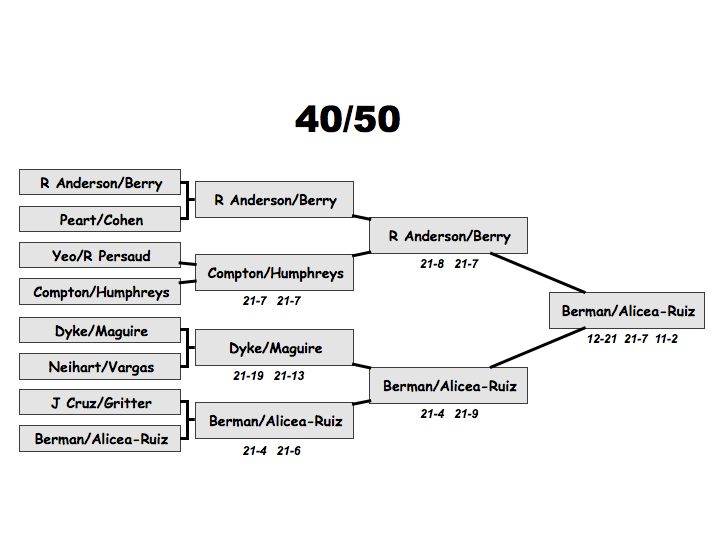
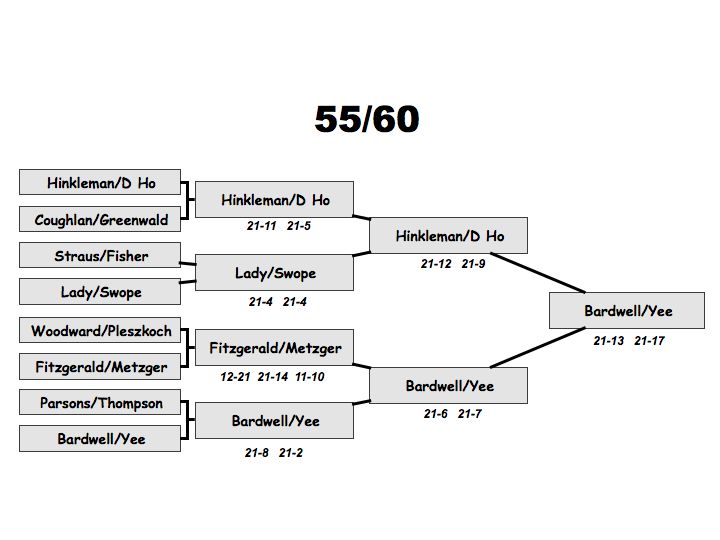
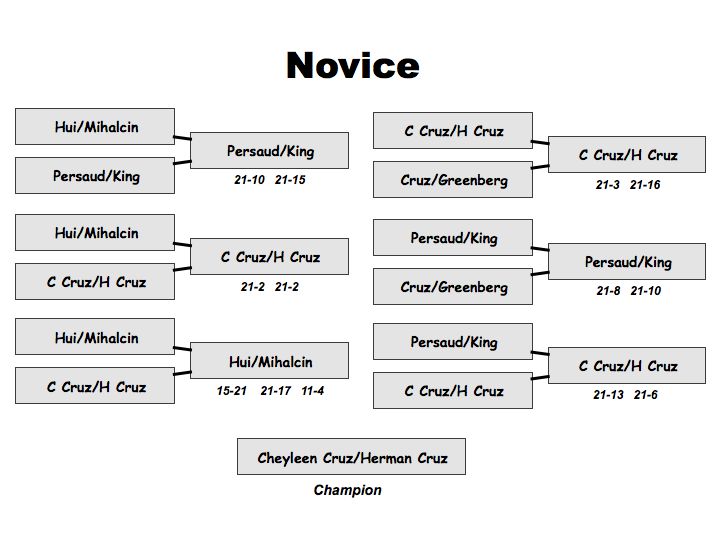
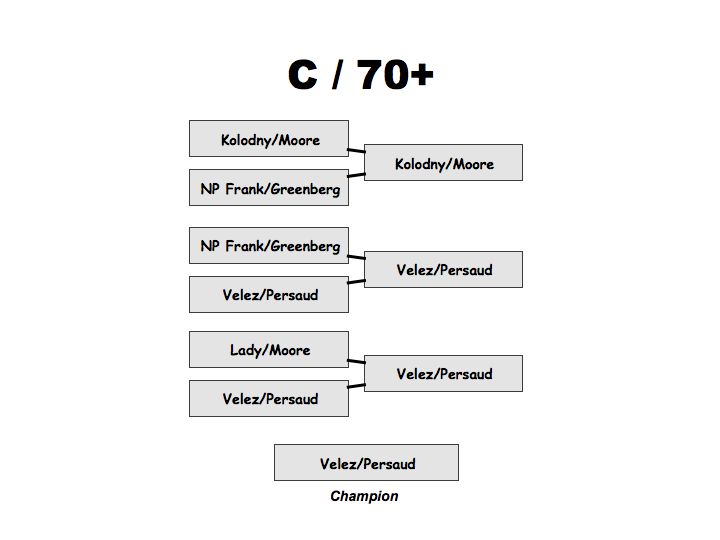
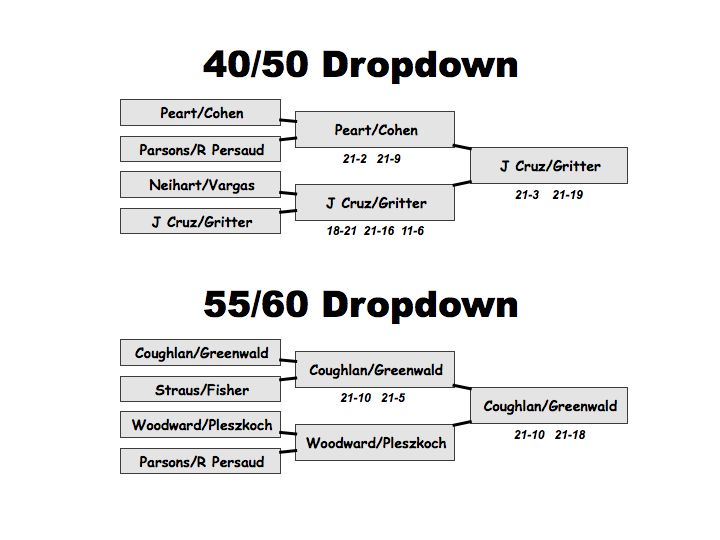


 As a participant, one is guaranteed no fewer than 3 matches, in this case, 3 games. This is an open tournament played in a round robin format. Points are awarded to the winner of each game based on the margin of victory. After the initial 3 rounds, the eight players with the total highest points will then advance to a single elimination championship round. A handicap system was used for all rounds throughout the tournament to help compensate for age level differences. Because of this somewhat unique system of seeding and scoring, trophies are awarded for first and second place Open (winner and runner up of the final eight), Masters, Diamond, Golden, and Super.
As a participant, one is guaranteed no fewer than 3 matches, in this case, 3 games. This is an open tournament played in a round robin format. Points are awarded to the winner of each game based on the margin of victory. After the initial 3 rounds, the eight players with the total highest points will then advance to a single elimination championship round. A handicap system was used for all rounds throughout the tournament to help compensate for age level differences. Because of this somewhat unique system of seeding and scoring, trophies are awarded for first and second place Open (winner and runner up of the final eight), Masters, Diamond, Golden, and Super.